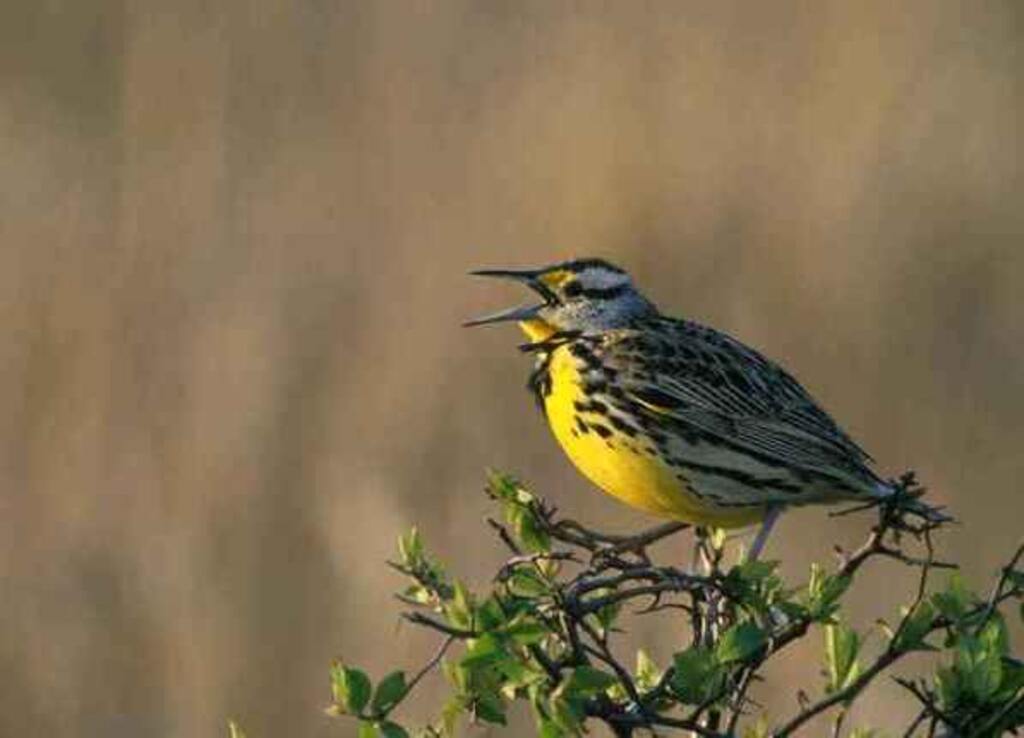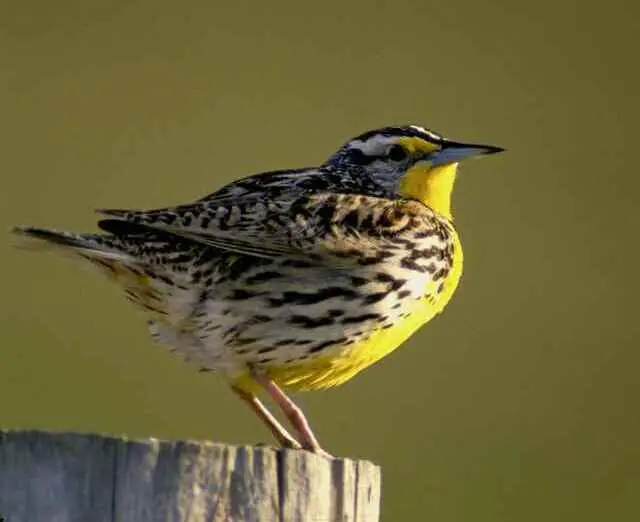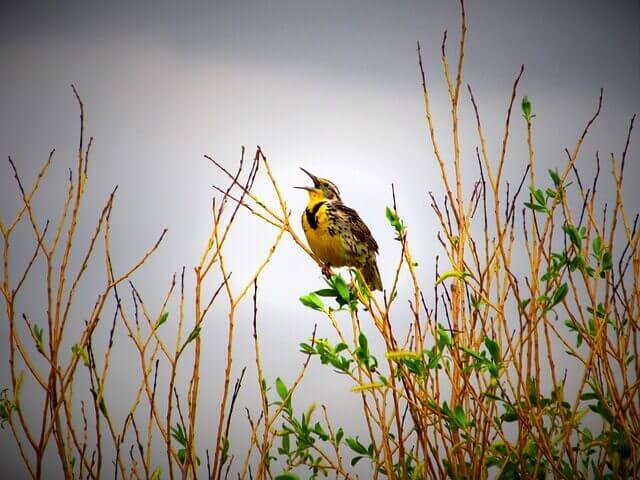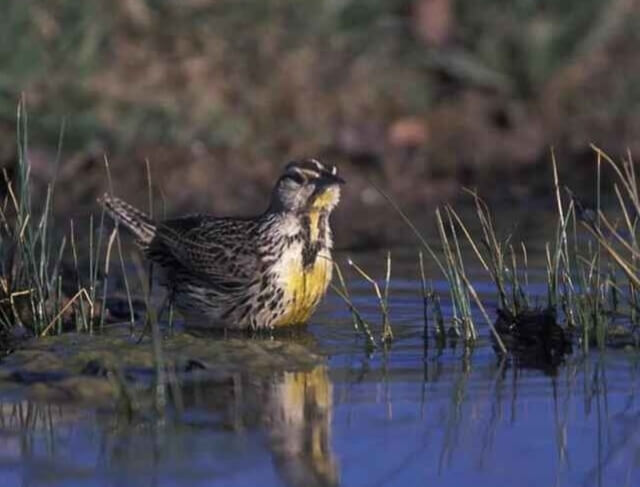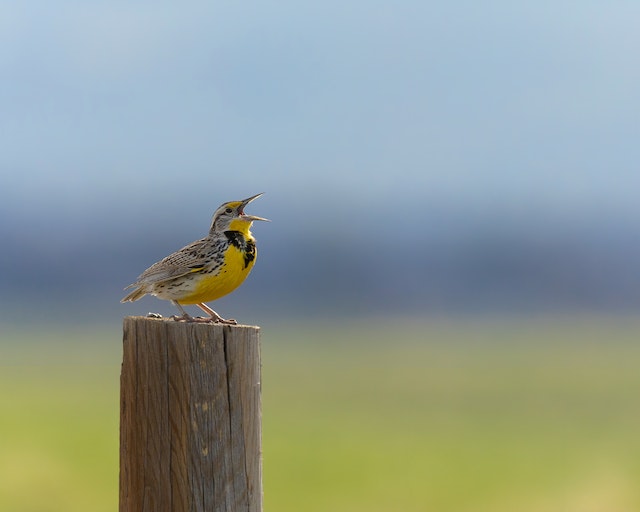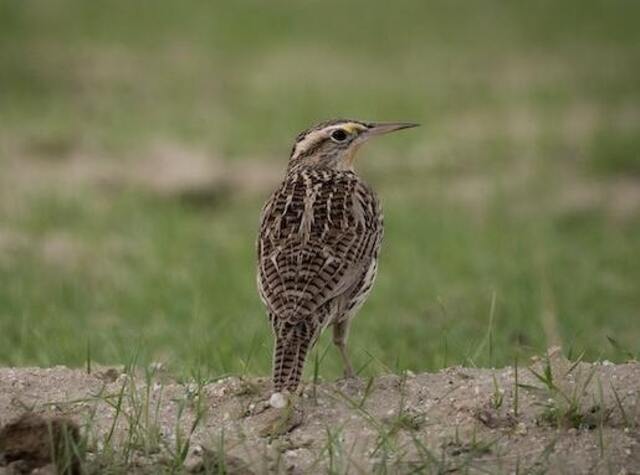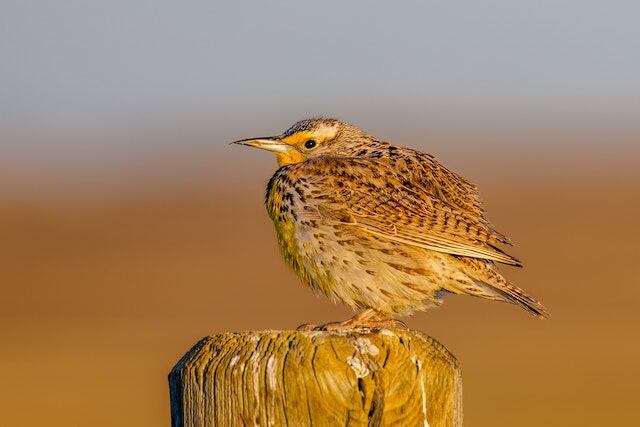Are you ready to learn some fun and fascinating Western Meadowlark Bird Facts?
These charming little birds are more than just a pretty face – they have a unique behavior, interesting vocalizations, and a fascinating life cycle.
Whether you’re a seasoned birder or just looking to expand your knowledge of the natural world, this article has something for everyone. So, what are you waiting for? Let’s dive in!
Table of Contents
- 1 Key Takeaways
- 2 Identification
- 3 Size
- 4 Behavior
- 5 Habitat And Range
- 6 Calls And Songs
- 7 Diet
- 8 Breeding And Reproduction
- 9 Adaptability
- 10 Migration Pattern
- 11 Predators
- 12 Lifespan
- 13 Conservation Status
- 14 Interesting Western Meadowlark Bird Facts
- 15 Attracting Western Meadowlarks
- 16 Conclusion
- 17 Frequently Asked Questions
- 18 Author
Key Takeaways
- The Western Meadowlark is a striking bird that can be easily identified by its unique plumage, including a black and buff pattern on its upper body and a large black “V” on its chest.
- These birds are highly active during the day, spending most of their time foraging for food and singing beautiful songs. They are ground-feeding birds that eat a variety of foods, including insects, berries, and seeds.
- The Western Meadowlark nests on the ground and is known to be fairly territorial during breeding season, often chasing off other males and defending their territory from predators like coyotes or foxes.
- This bird is migratory, spending its winters in the Southern United States and Mexico and migrating back to its summer habitat in Canada during late April or early May.
- While the Western Meadowlark is not endangered and is of the least concern, it is often targeted by predators such as owls, cats, snakes, eagles, raccoons, coyotes, and weasels.
Identification
The Western Meadowlark is a striking bird that can be easily identified by its unique plumage. Its upper body is adorned with a striking black and buff patterning, which contrasts with its bright yellow underbelly.
One of the most distinctive features of the Western Meadowlark is the large black “V” on its chest, which stands out against the bird’s bright yellow plumage.
When it comes to the head, the Western Meadowlark lacks a crest, but instead has feathers that are striped white and brown.
This unique pattern of feathers helps the bird blend in with its surroundings, making it a master of camouflage.
Male and female Western Meadowlarks are similar in appearance, with both sexes sporting a bright yellow breast, brown back, and black V-shaped collar.
Size
There are some subtle size differences between males and females. On average, male Western Meadowlarks are slightly larger than females, with longer wings, longer tails, and a heavier body weight.
This size difference is thought to be related to the male’s role in courtship and territorial defense, as larger males may be better able to compete for mates and resources.
However, the differences in size between males and females are relatively small, and may not be noticeable to the casual observer.
- Length: 6.5-10.5 in (16.5-26.7 cm)
- Weight: 3.0-4.0 oz (85-113 g)
- Wingspan: 16.0 in (40.5 cm)
Behavior
One of the most interesting things about the Western Meadowlark is its behavior. These birds are highly active during the day, spending most of their time foraging for food and singing beautiful songs.
However, at night, they become much more subdued, moving slowly into cover to rest and avoid predators. This makes them a fascinating species to observe and study.
Habitat And Range
The Western Meadowlark is a highly adaptable bird that can be found in a wide variety of habitats across its range.
While it prefers open areas with plenty of trees and shrubs, such as grasslands, prairies, and agricultural fields, it can also be found in wetlands, deserts, and even urban areas.
This bird is commonly found in Western North America and Canada, as well as coastal regions in Mexico.
In fact, it is one of the most widespread and abundant birds in these areas, with populations numbering in the millions.
The Western Meadowlark is known for its ability to move quickly and efficiently across its range, making it a highly mobile species.
It is also able to adapt to changing environmental conditions, which has helped it to thrive in a variety of different habitats.
While the Western Meadowlark is found throughout much of Mexico, it is notably absent from mountainous regions.
This is likely due to the bird’s preference for open areas with plenty of vegetation, which are scarce in mountainous regions.
Overall, the Western Meadowlark is a highly adaptable and widespread species that is well-suited to a variety of different habitats.
Its ability to thrive in changing environments has helped it to maintain healthy populations across its range.
Calls And Songs
While the Western Meadowlark may not be as vocal as some other songbirds, its unique song is a joy to hear.
When disturbed, it may emit soft noises or chirps, but when it sings, its high-pitched melody is unmistakable.
The song is often repeated in a variety of ways, showcasing the bird’s impressive vocal range.
This adaptation helps it blend in with its surroundings and communicate with other meadowlarks across wide distances.
As a birder, listening for the Western Meadowlark’s song is a treat and a testament to the beauty of the natural world.
Diet
As ground-feeding birds, Western Meadowlarks rely on a diverse diet to maintain their health and energy levels.
Insects make up the majority of their diet, with ants, grasshoppers, crickets, carpenter ants, flies, cockroaches, mosquitoes, and other insects all on the menu.
However, they also supplement their diet with plant-based foods such as berries, pine cones, acorns, and seeds.
These adaptable birds have even been observed eating seed pods from dead plants or scavenging in harvested cornfields.
Understanding the Western Meadowlark’s diet sheds light on its role in the ecosystem and its unique feeding behaviors.
Breeding And Reproduction
The Western Meadowlark’s nesting habits are closely tied to its preferred habitat. These ground-nesting birds typically choose sites near moist areas such as wetlands or creeks, where they can find the necessary resources for building their nests.
They often use natural features like hollow logs, rock crevices, and hollowed-out trees, but have also been known to nest in other birdhouses or old birdhouses.
Meadowlarks lay 4–6 eggs that take 16 days to hatch, and the parents are highly dedicated to the survival of their young.
They are generally monogamous and mate for life, but in some cases, a bird may breed with another male if their partner dies or disappears during incubation.
During breeding season, Western Meadowlarks can be quite territorial and fiercely defend their nests from potential predators like coyotes or foxes.
Observing these behaviors can provide insight into the complex social dynamics of these fascinating birds.
Adaptability
Western Meadowlarks are highly adaptable and can thrive in various habitats, including grasslands, prairies, agricultural fields, wetlands, and even urban areas. They have the ability to adjust to changing environmental conditions.
Migration Pattern
As a migratory bird, the Western Meadowlark embarks on a remarkable journey each year. During the winter months, these birds can be found in the Southern United States and Mexico, where they seek out warmer climates and ample food sources.
However, as spring approaches, they begin their long journey back to their summer breeding grounds in Canada.
The length of the Western Meadowlark’s migration can vary, ranging from five months during the winter to up to nine months during the summer breeding season.
During this time, the birds follow rivers and other natural features as they make their way across the vast plains of states like Nebraska, Montana, Wyoming, and South Dakota.
In the winter, Western Meadowlarks can be found in the warmer climates of southern Arizona, New Mexico, and California, where they continue to feed and prepare for their long journey back north.
Understanding the intricacies of the Western Meadowlark’s migration patterns provides a deeper appreciation for the challenges these birds face and the importance of their conservation.
Predators
As with many birds, the Western Meadowlark faces a variety of predators in its natural habitat. Among the most common predators are owls, cats, snakes, eagles, raccoons, coyotes, weasels, and hawks.
These animals pose a constant threat to the meadowlark’s safety and survival, and the birds have developed several adaptations to protect themselves from attack.
One such adaptation is their use of a unique singing technique.
When threatened, Western Meadowlarks will make a short sound with an incomplete or unusual trill pattern before continuing on with their usual song.
This distraction technique can confuse predators and give the meadowlark an opportunity to escape.
Understanding the Western Meadowlark’s predators and defense mechanisms provides valuable insight into the challenges these birds face in the wild.
It also underscores the importance of conservation efforts to protect these and other vulnerable species.
Lifespan
The lifespan of the Western Meadowlark is influenced by a variety of factors, including access to food, habitat quality, and the presence of predators or other threats.
In the wild, these birds typically live for 2–4 years, but they can live up to 10 years in captivity under optimal conditions.
While their lifespan may be relatively short, Western Meadowlarks play an important role in their ecosystem and are a valuable part of the natural world.
As such, conservation efforts are crucial to ensuring their continued survival.
By protecting their habitat, reducing threats from predators and other sources, and promoting sustainable practices, we can help ensure that these beautiful birds thrive for generations to come.
Conservation Status
While many bird species face threats to their survival due to human activities, the Western Meadowlark is not currently endangered and is considered to be of least concern.
This is due in part to the fact that populations of these birds have been increasing in recent years.
The Western Meadowlark has been classified as least concern on the IUCN Red List since 1994, thanks to its stable and growing population.
However, this does not mean that these birds are completely out of danger. Like all birds, Western
Meadowlarks face threats from predators such as hawks and owls, as well as habitat loss and other environmental factors.
As birders and conservationists, it is important to remain vigilant and continue to support efforts to protect the Western Meadowlark and its habitat.
By working together, we can help ensure that this beautiful and iconic bird continues to thrive for generations to come.
Interesting Western Meadowlark Bird Facts
- The Western Meadowlark has a unique habit of using cow dung as a platform to sing from, possibly to attract mates or defend its territory.
- These birds have a specialized muscle in their throat that allows them to produce complex songs with multiple notes.
- Western Meadowlarks have been observed using tools, such as using sticks, to remove insects from crevices.
- The bird’s Scientific Name, Sturnella neglecta, means “neglected little starling”.
- The Western Meadowlark is sometimes mistakenly called a lark, but it is actually a member of the blackbird family.
- The bird’s bright yellow coloration is caused by the pigment xanthophyll, which is derived from the bird’s diet of insects and seeds.
- Western Meadowlarks can fly up to 35 miles per hour.
- These birds have a unique way of taking off, where they run along the ground for a short distance before launching into the air.
- The Western Meadowlark’s eyes are positioned on the sides of its head, giving it a wide field of vision to spot predators.
- In some Native American cultures, the Western Meadowlark is considered a symbol of joy and happiness.
- The Western Meadowlark has been observed using its bill to dig through snow to find food during the winter.
- These birds are known to engage in “anting”, where they rub ants on their feathers to remove parasites.
- Western Meadowlarks have been observed bathing in shallow puddles or dewy grass to keep their feathers clean.
- The bird’s song has been described as sounding like “spring of the year” or “sweet sweet sweet”.
- Western Meadowlarks have a unique way of defending their territory, where they will fly up and hover in the air while singing loudly.
- These birds have a complex social hierarchy, with dominant males having larger territories and more mates.
- The Western Meadowlark’s eggs are sometimes parasitized by other bird species, such as the Brown-headed Cowbird.
- These birds have a unique way of communicating with each other, where they will use body language such as tail flicks and wing displays.
- Western Meadowlarks have been observed using their beaks to break open the shells of snails and other hard-shelled invertebrates.
Attracting Western Meadowlarks
Western Meadowlarks are frequently found in urban habitats such as parks, golf courses, yards, pastures, fields, and shrub lands. If you’re interested in attracting these beautiful birds to your own yard, here are ten useful tips to follow.
Check out the recommended products with direct links to Amazon below for added convenience.
1) Feed the birds with a platform bird feeder, or at ground level with mealworms, or suet.
2) Leave out a feeder filled with black oil sunflower seeds or mixed seed blend. This Squirrel-proof Bird Feeder is a great option. Find the lowest price on Amazon.
3) Spread wheat or cracked corn on the ground or on a platform bird feeder to lure them closer for more interaction.
4) Place nest boxes in your backyard, and keep an eye on it.
5) Plant native flowers in your garden such as Russian sage, goldenrod, purple prairie, yarrow, cattails, milkweed, jewel weed, thistle fennel, and aster.
6) Plant seeds of fruit trees like apple or cherry.
7) One great idea is using one or two brightly colored pieces of fruit that are hard to miss, such as blueberries, raspberries, blueberry berry, blueberry, blackberry, cranberry, strawberries, and cherry tomatoes.
8) Provide a shallow water source like a bird bath or pond: The bird will need to bathe in order to keep cool during the summer months when it is most active.
9) Add large piles of brush or logs on the ground
10) One of the most important things you have to remember is that you have to be consistent with the whole process. No matter what type of bird you are trying to attract.
Conclusion
In conclusion, Western Meadowlarks are fascinating birds with their striking plumage, beautiful songs, and unique behaviors.
They are common residents in various habitats and can be found in urban areas, parks, golf courses, yards, pastures, fields, and shrub lands.
By understanding their identification, behavior, habitat, diet, breeding, migration, predators, and conservation status, we gain a deeper appreciation for these remarkable birds.
Whether you’re a bird enthusiast or simply curious about the natural world, exploring the Western Meadowlark’s captivating characteristics adds a touch of wonder to our understanding of the avian world.
Frequently Asked Questions
What is the Western Meadowlark known for?
The Western Meadowlark is known for its striking plumage, including a black and buff pattern on its upper body and a bright yellow underbelly. Its beautiful and melodic song is a highlight, and it is highly active during the day, foraging for food and singing. Ground-nesting habits, migratory nature, and adaptability to various habitats further distinguish this species.
Do female Western Meadowlarks sing?
No, female Western Meadowlarks do not sing. It is the male Western Meadowlarks that are known for their distinct and melodious song. The males use their song to establish and defend their territories, as well as to attract mates during the breeding season. In contrast, female Western Meadowlarks may vocalize with soft noises or chirps, but they do not produce the elaborate songs that males are known for.
What is the class of the Western Meadowlark?
The Western Meadowlark belongs to the class Aves, which encompasses all birds. Birds are classified under the class Aves, the order Passeriformes (which includes perching birds), and the family Icteridae (which includes blackbirds, orioles, and meadowlarks).
Are Western Meadowlarks rare?
Western Meadowlarks are not considered rare. They have stable populations in Western North America, Canada, and coastal regions of Mexico. While abundance can vary, they are relatively common in grasslands, prairies, and agricultural fields. Monitoring and conservation efforts are still important for their well-being.
Do Western Meadowlarks eat other birds?
While Western Meadowlarks primarily feed on insects, seeds, and grains, they have been observed consuming small birds on rare occasions. However, this behavior is not a significant part of their diet. Their main food sources include insects, berries, seeds, and plant matter.

